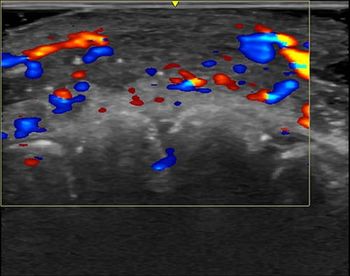When metastasis-directed therapy (MDT) is performed for patients with oligorecurrent prostate cancer (PCa), imaging guidance with prostate-specific membrane antigen (PSMA) positron emission tomography/computed tomography (PET/CT) may facilitate significantly longer progression-free survival (PFS) than choline PET/CT guidance.
In a retrospective study, recently published in the Journal of Nuclear Medicine, researchers compared PSMA PET/CT-guided MDT versus choline PET/CT-guided MDT. Each cohort had 120 patients with oligorecurrent PCa. Physicians utilized (18F)fluorocholine for all patients in the choline PET/CT group while those in the PSMA PET/CT group had scans with (68Ga)Ga-PSMA-11 or (18F)F-PSMA-1007, according to the study.
The researchers found that 86.7 percent of patients (104/120) in the choline PET/CT group experienced post-MDT PCa progression in comparison to 49.2 percent (59/120) in the cohort that had PSMA PET/CT-guided MDT. Patients in the PSMA PET/CT group also had a 33.2 month median PFS in contrast to 13.8 months for patients who had choline PET/CT guided MDT.
“ … We observed a significantly longer median PFS in patients undergoing PSMA PET/CT–guided MDT than in those undergoing choline PET/CT–guided MDT,” wrote lead study author Matteo Bauckneht, M.D., a nuclear medicine researcher affiliated with IRCCS Ospedale Policlinico San Martino in Genova, Italy, and colleagues.
Noting that the few studies that have compared (68Ga)Ga-PSMA-11 and (18F)F-PSMA-1007 have primarily focused on diagnostic accuracy, the study authors also evaluated the impact of both PET radiotracers for MDT guidance in 44-patient, propensity-matched cohorts.
(Editor’s note: For more content on prostate cancer imaging, click here.)
Three Key Takeaways
- Significant improvement in progression-free survival (PFS). Patients with oligorecurrent prostate cancer who underwent PSMA PET/CT-guided metastasis-directed therapy (MDT) experienced a significantly longer median PFS (33.2 months) compared to those who had choline PET/CT-guided MDT (13.8 months).
- Reduced post-therapy prostate cancer (PCa) progression. The research indicated that a smaller percentage of patients (49.2 percent) experienced post-MDT progression in the PSMA PET/CT group compared to the choline PET/CT group (86.7 percent), demonstrating the superior efficacy of PSMA PET/CT in guiding MDT.
- Lower nadir prostate-specific antigen (PSA) serum levels. The study authors observed that patients in the (68Ga)Ga-PSMA-11 guidance group had significantly lower nadir PSA serum levels (0.53 ng/mL) compared to those in the (18F)F-PSMA-1007 guided group (1.69 ng/mL), suggesting better treatment targeting and effectiveness.
Patients in the (68Ga)Ga-PSMA-11 guidance group had a significantly lower nadir prostate-specific antigen (PSA) serum level than those who had (18F)F-PSMA-1007 guided MDT (0,53 ng/mL vs. 1.69 ng/mL), according to the researchers. They also pointed out that (68Ga)Ga-PSMA-11 guidance for MDT resulted in more than a 19-month difference in median PFS (41.5 months vs. 22.4 months for (18F)F-PSMA-1007 guidance.
“One possible explanation for our findings is the propensity of (18F)F-PSMA-1007 to exhibit unspecific bone uptake, potentially leading to false-positive results. Mistaking unspecific uptake for metastatic lesions could result in inappropriate targeting during stereotactic body radiotherapy, thereby affecting the tracer’s effectiveness in guiding MDT,” posited Bauckneht and colleagues.
(Editor’s note: For related content, see “Study Examines Prognostic Value of 68Ga-PSMA-11 PET/CT for Patients at High Risk of PCa,” “Study: PSMA PET/CT Agent May Rule Out csPCa in 93 Percent of PI-RADS 3 Lesions” and “ECR Study Examines Key Predictive Factors for Metastasis in Patients with High-Risk Prostate Cancer.”)
Beyond the inherent limitations of a retrospective, observational study, the researchers acknowledged that limited statistical power may limit extrapolation of the study findings to a broader population. They also noted that the type and duration of androgen deprivation therapy (ADT) utilized prior to MDT were not assessed. The study authors pointed out a trend of more frequent use of concurrent ADT with PSMA-matched cohorts in contrast to choline PET/CT cohorts.





























